Fire ban and air support could help end wildfires, says charity
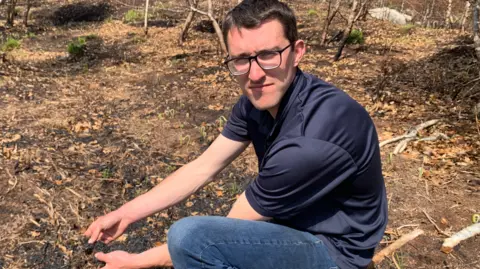 BBC
BBCA group picking up the pieces after wildfires devastated thousands of acres in and around the Mourne mountains is calling for clarity on what can be done to prevent blazes and tackle them.
Mourne Heritage Trust estimates a fire in Silent Valley in April spread over 1,500-1,700 acres.
The group says Stormont should consider banning fires at certain times of year and has questioned whether a helicopter could have been used to fight the blaze.
The Department for Agriculture, Environment and Rural Affairs (Daera) said it would consider banning fires, while the Northern Ireland Fire and Rescue Service (NIFRS) said a helicopter would not have been appropriate due to a number of operational factors.
Andrew Baird from Mourne Heritage Trust said there was "virtually nothing left" on land he assessed close to Ben Crom dam.
"You've got no habitat for reptiles, insects and small birds. Everything is gone," he said.
The fire burned for four days and had to be tackled by physically beating it.
"There was water all around here and we were just using shovels," he said.
"We were pushing for a helicopter but apparently it wasn't available."
A spokesperson for NIFRS said the service does not have immediate access to firefighting aircraft and had to request them.
"In this circumstance, the use of a helicopter as a water resource was not requested due to a number of factors including; wind direction and speed, nature and size of the fire front and the impact on operational activity on the ground," the spokesperson said.
"This was an operational risk based decision and was not based on budget."
They said NIFRS worked with a number of other agencies to ensure they used the best approach to fighting the fire.
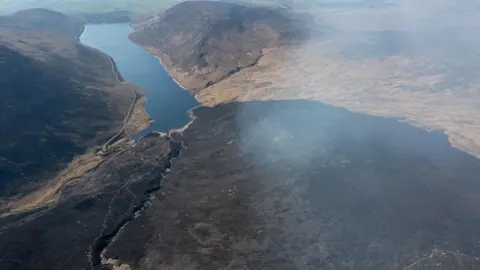 NI Water
NI WaterMr Baird said fires should be banned in mountainous areas when there is an amber or red wildfire warning issued.
Daera said it would be open to this but it would require a new law to be passed by Stormont and there was a tight timetable because the assembly did not sit for almost two years from 2022 to 2024.
"This is however something that could be assessed as part of any future package of wider legislative review," a spokesperson said.
What sort of damage was caused to the Mournes?
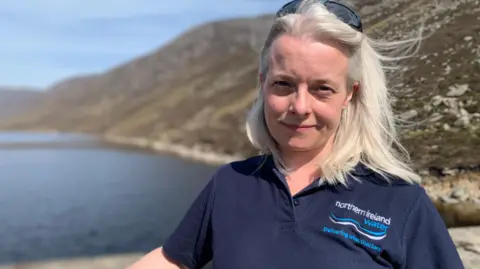
Most of the land where "the deeper, slower burn damage" happened is in the harder to access areas higher up.
Rebecca Allen from NI Water, which manages Silent Valley reservoir, said it had not been able to access the site to do an ecological survey yet.
"The habitat up there is a bit of a mosaic. There's areas of deep peat - which is peat that is deeper than 50cm," she said.
"There's shallow peat, there's Montane heath , just a very rare high altitude habitat. There's heathers, sphagnum mosses - a mixture of all very different species and different habitats."
The concern is that the top layer of vegetation has been destroyed which leaves the ground exposed.
"That's what we don't want to be eroding down into our water here," she said.
Although it wouldn't pose any risk to drinking water "there's potentially a higher expense in treatment chemicals and electricity" to get it to the same standard.
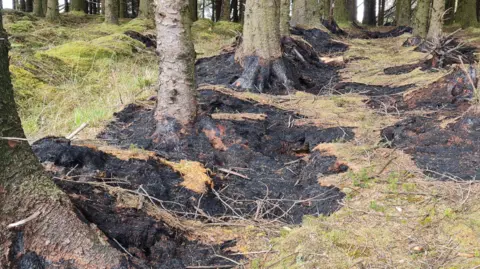 JohnRoss McMahon
JohnRoss McMahonOn the Sandbank Road between Hilltown and Rostrevor the fire damaged land is easier to access but not so easy to restore.
Local environmentalist JohnRoss McMahon was here the night a major incident was declared and homes had to be evacuated.
He has been back to take a closer look at the damage.
"The one word I would say - it's permanent," he said.
"There's much deeper damage where the fire has got under the peat and has burned under the ground.
"You can see the pits where the peat has burned away and the soil has essentially collapsed."
He said it was not just a matter of leaving it alone but that something had to be done to bring it back to its natural state.
Daera said funding for peatland restoration projects was planned at various sites across Northern Ireland.
"A Peatland Strategy is also due to be published soon once Stormont executive approval is obtained to drive a wider and collaborative approach to achieve enhanced and sustained peatland restoration," a spokesperson said.
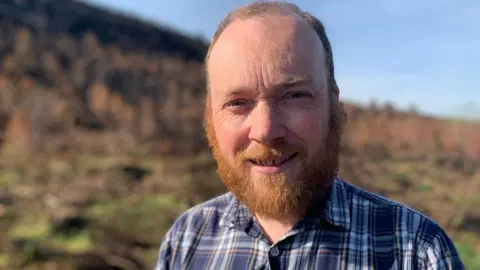
At Silent Valley new approaches are being tried to encourage the land to recover quicker.
Mr Baird said the heritage trust was piloting a scheme of "hydro seeding".
"Basically we're spreading a seed mixture over the surface of the ground which will increase the amount of vegetation cover that will be here over the winter," he said.
But that is only to be trialled in one small area - most of it could take up to 10 years to return to "like for like".
